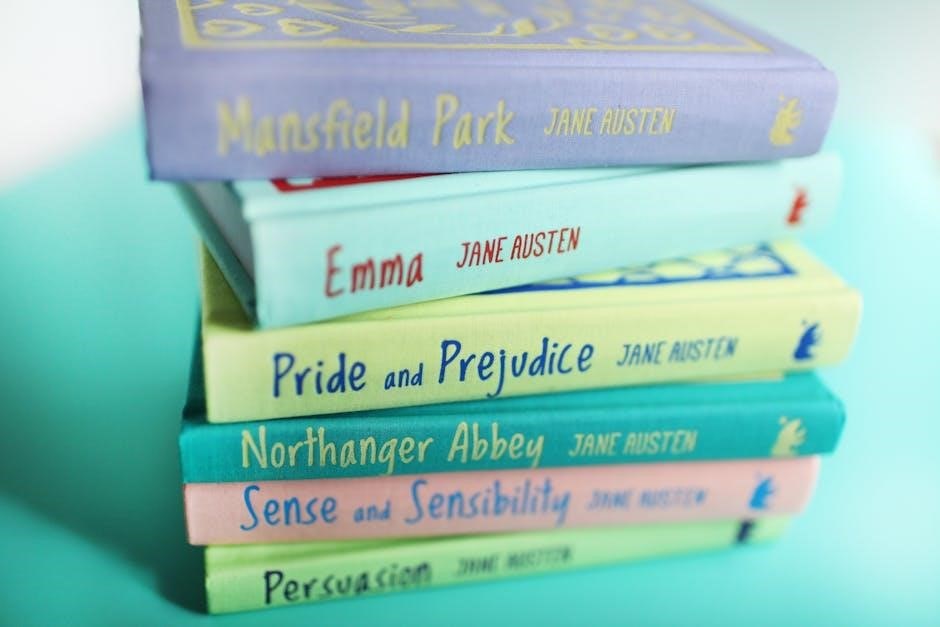Charles Dickens’ beloved novel, David Copperfield, is a timeless tale of growth, love, and resilience, blending autobiographical elements with vivid societal commentary, remaining a cherished classic.
1.1. Overview of the Novel

David Copperfield is a coming-of-age novel that follows its titular protagonist through a journey of self-discovery, love, and hardship. The story begins with David’s idyllic childhood, which is disrupted by his mother’s remarriage to the cruel Mr. Murdstone. After being sent to boarding school and later forced to work in a factory, David navigates a complex web of relationships and societal challenges. The novel is deeply autobiographical, reflecting Dickens’ own experiences of poverty and personal struggle. Through vivid characters like the charismatic Mr. Micawber and the deceitful Uriah Heep, Dickens explores themes of identity, class, and morality. The narrative’s rich emotional depth and poignant commentary on Victorian society make it a timeless classic, cherished for its relatable protagonist and universal themes.

1.2. Importance of the PDF Version
The PDF version of David Copperfield offers unparalleled accessibility, allowing readers to engage with Dickens’ masterpiece anytime, anywhere. This format preserves the original text’s integrity, ensuring that the novel’s intricate language and structure remain unchanged. The PDF is particularly valuable for students and scholars, as it enables easy annotation and reference. Additionally, its digital nature makes it environmentally friendly and cost-effective, democratizing access to this literary treasure. The availability of free versions, such as those from Project Gutenberg, further enhances its reach, introducing Dickens’ work to new generations of readers. The PDF format thus serves as a vital tool in keeping David Copperfield relevant and accessible in the modern era, ensuring its enduring legacy for years to come.

Author Background
Charles Dickens, born in 1812 to a middle-class family, drew heavily from his life experiences, mirroring his own struggles and inspirations in David Copperfield, his cherished masterpiece.
2.1. Charles Dickens and His Life
Charles Dickens, one of the most celebrated English novelists, was born on February 7, 1812, in Portsmouth, England. His early life was marked by financial instability, as his father, John Dickens, struggled with debt. This hardship deeply influenced Dickens’ writing, particularly in David Copperfield, where he reflects on his own experiences of poverty and resilience.
Dickens’ career began in journalism, but his literary talent soon flourished. His novels, known for their vivid characters and social commentary, captured the essence of Victorian life. David Copperfield, often regarded as his most autobiographical work, mirrors Dickens’ journey from childhood struggles to literary success, making it a testament to his enduring legacy.
2.2. Autobiographical Elements in “David Copperfield”
Charles Dickens wove significant autobiographical elements into David Copperfield, reflecting his own life experiences. David’s childhood poverty and struggles mirror Dickens’ early years, particularly his father’s financial difficulties, which inspired the character of Mr. Micawber. Dickens’ time working at a blacking factory as a boy is echoed in David’s employment at Murdstone and Grinbys, highlighting themes of resilience and hardship. Additionally, Dickens’ passion for writing and his eventual rise to success are paralleled in David’s journey. These personal touches infuse the novel with authenticity, making it a deeply personal and relatable story. The overlap between Dickens’ life and David’s narrative underscores the novel’s emotional depth and connection to its author’s history.

Plot Summary
David Copperfield traces the titular character’s journey from birth through adulthood, navigating love, loss, and self-discovery in Victorian England, shaped by vivid experiences and memorable encounters.
3.1. Early Life of David Copperfield
David Copperfield’s early life is marked by both joy and hardship. Born to a widowed mother, Clara, he experiences a brief idyllic childhood. However, his life takes a dramatic turn with the arrival of his stepfather, Mr. Murdstone, who imposes a strict and oppressive regime. After his mother’s tragic death, David is sent to work at Murdstone and Grinbys, a wine bottling factory, where he endures harsh conditions. Despite these challenges, David finds solace in the kindness of characters like Betsey Trotwood and Peggotty, who play pivotal roles in shaping his early years. These formative experiences lay the foundation for his resilience and character development, reflecting Dickens’ own autobiographical influences.
3.2. Major Events in the Novel
The novel unfolds with David’s birth and his early life under the guardianship of his widowed mother. A turning point occurs when his mother marries the cruel Mr. Murdstone, leading to a oppressive household. After his mother’s untimely death, David is sent to work in a wine bottling factory, marking a period of hardship. He later escapes to his aunt Betsey Trotwood, who becomes a pivotal figure in his life. The narrative progresses through his schooling at Salem House, where he befriends Steerforth and Traddles, and his infatuation with Emily, whose elopement with Steerforth brings turmoil. David’s marriages, first to the youthful Dora and later to the steadfast Agnes, are central to his emotional journey. The betrayal by Uriah Heep and the eventual exposure of his deceit, alongside Mr. Micawber’s unwavering optimism, drive the plot toward resolution. The novel concludes with David reflecting on his life, highlighting themes of resilience and personal growth. These events collectively shape the narrative, offering profound insights into David’s character and the world around him.
3.3. Narrative Structure
David Copperfield is notable for its fluid narrative structure, blending chronological storytelling with reflective insights. The novel, originally serialized, maintains an episodic feel, with each chapter advancing the plot while delving into character development. Dickens employs a first-person perspective, allowing David to recount his life with hindsight, adding depth to his experiences. The PDF version preserves this structure, with numbered sections and a detailed table of contents that enhance readability. The narrative transitions seamlessly between past and present, using flashbacks and introspection to explore themes of memory and personal growth. This structure not only maintains reader engagement but also provides a coherent framework for analyzing the novel’s intricate layers, making the PDF format an excellent choice for both casual readers and scholars seeking to explore Dickens’ masterpiece in depth.

Major Characters
Dickens masterfully crafts a diverse cast, with David Copperfield at the center, supported by iconic figures like Uriah Heep and Betsey Trotwood, each enriching the narrative with unique traits and depth.
4.1. David Copperfield: The Protagonist
David Copperfield, the protagonist, narrates his journey from childhood to adulthood, offering a deeply personal and semi-autobiographical account of his life. Kind, sensitive, and resilient, David faces numerous challenges, including the loss of his father, the cruelty of his stepfather, Mr. Murdstone, and his struggles in boarding school. His relationships with figures like the eccentric Miss Betsey Trotwood and the endearing Micawbers shape his character and provide emotional support. David’s eventual success as a writer reflects his determination and growth. As Dickens’ favorite character, David embodies the universal quest for identity and belonging, making him one of literature’s most relatable and memorable heroes. His story, filled with both sorrow and hope, resonates with readers, showcasing Dickens’ mastery of human psychology and emotional depth.
4.2. Uriah Heep and Other Key Characters
Uriah Heep, one of Dickens’ most memorable antagonists, is a master of hypocrisy, masking his cunning nature with feigned humility. His rivalry with David and manipulation of others highlight his deceitful character, ultimately leading to his downfall. Another notable figure is Mr. Micawber, whose relentless optimism and financial struggles provide both humor and pathos. His unwavering loyalty to David underscores the novel’s themes of friendship and resilience. Additionally, characters like Betsey Trotwood, with her eccentric yet protective nature, and the tragic Em’ly, whose fate serves as a cautionary tale, enrich the narrative. Dickens’ vivid portrayal of these characters, each with their unique flaws and virtues, enhances the novel’s depth and complexity, offering insights into human nature and Victorian society. Their roles intertwine seamlessly, creating a tapestry of experiences that shape David’s journey.
4.3. The Role of Betsey Trotwood
Betsey Trotwood, David’s eccentric yet fiercely protective aunt, plays a pivotal role in shaping his life. Her unconventional wisdom and strong will provide a stark contrast to the oppressive figures in David’s early years. Betsey’s unwavering support, particularly in rescuing him from the Murdstones, exemplifies her maternal instincts and determination. Her iconic line, “I don’t want any of that,” reflects her no-nonsense attitude, while her kindness and generosity offer David a sense of belonging. Throughout the novel, Betsey remains a constant source of comfort and guidance, embodying the theme of resilience and the impact of steadfast love. Her character adds depth to the narrative, showcasing Dickens’ ability to craft strong, independent female figures who defy societal norms. Betsey Trotwood’s influence on David is profound, leaving an indelible mark on his journey.

Themes and Analysis
Heroism, social class struggles, and personal growth are central themes in David Copperfield. The novel explores resilience, moral integrity, and the complexities of human nature, offering timeless insights into Victorian society and individual transformation.
5.1. The Concept of the Hero
The concept of the hero in David Copperfield is explored through the titular character’s journey. David’s heroism is not traditional; instead, it is rooted in resilience, empathy, and self-awareness. His growth from a vulnerable child to a confident adult underscores the idea that heroism lies in overcoming personal struggles and moral integrity. Unlike classical heroes, David’s strength is in his ability to learn from mistakes and remain compassionate. Dickens portrays heroism as an internal journey, emphasizing the importance of self-reflection and personal growth. Through David’s experiences, the novel redefines heroism, making it accessible and relatable to ordinary individuals. This interpretation resonates deeply, highlighting the hero within everyday life.
5.2. Social Commentary in the Novel
David Copperfield serves as a powerful critique of Victorian society, addressing issues like child labor, class inequality, and the exploitation of the poor. Dickens highlights the harsh realities faced by children in workplaces such as Murdstone and Grinbys, mirroring his own experiences. The novel also examines the flawed education system, portraying schools like Salem House as oppressive institutions. Through characters like Uriah Heep, Dickens exposes religious hypocrisy and social climbing. Additionally, the novel critiques the limited roles of women, showcasing strong female figures like Betsey Trotwood who defy societal norms. By blending personal and societal struggles, Dickens provides a vivid commentary on the social ills of his time, emphasizing the need for reform and compassion.

5.3. Psychological Insights into Characters
David Copperfield offers profound psychological insights into its characters, exploring their inner struggles and emotional growth. David’s journey from innocence to maturity is marked by self-doubt, identity crises, and the pursuit of belonging. Dickens masterfully portrays the complexities of human nature through characters like Uriah Heep, whose hypocrisy and repressed ambition reveal the psychological toll of societal expectations. Betsey Trotwood’s resilience and unconventional wisdom highlight the strength of female characters in overcoming adversity. The novel also delves into themes of trauma, as seen in David’s childhood hardships, and the enduring impact of early experiences on adult psychology. Dickens’ autobiographical elements add depth, making the characters’ emotional journeys deeply relatable and authentically human.

Literary Significance
David Copperfield holds a revered place in Dickens’ works, cherished for its autobiographical depth and timeless themes, making it a cornerstone of English literature and enduringly popular.
6.1. Why It’s Dickens’ Favorite Novel
Charles Dickens often regarded David Copperfield as his favorite novel, largely due to its deeply personal nature. The story mirrors Dickens’ own life, with David’s journey reflecting his experiences of childhood poverty, family struggles, and eventual success as a writer. Dickens infused the novel with vivid autobiographical elements, such as David’s time at a bottling factory, which paralleled Dickens’ own employment at Warren’s Blacking Factory. The novel’s exploration of identity, resilience, and the complexities of human nature resonated profoundly with Dickens, making it a work of immense emotional and artistic significance for him. Its enduring popularity and relatability further solidified its place as a cherished creation in Dickens’ literary legacy.
6.2. Place Among Dickens’ Works
David Copperfield holds a unique position in Charles Dickens’ literary canon, often regarded as a transitional work between his early and late novels. Published in 1850, it followed the success of Oliver Twist and preceded Bleak House, showcasing Dickens’ evolving mastery of character development and narrative structure. The novel’s autobiographical elements and psychological depth set it apart from his other works, making it a favorite among readers and critics alike. Its enduring popularity and thematic richness have cemented its place as one of Dickens’ most celebrated novels, alongside Great Expectations and A Christmas Carol. David Copperfield remains a testament to Dickens’ ability to craft stories that resonate universally, blending humor, drama, and social commentary in a way that continues to captivate audiences.

Accessing “David Copperfield” in PDF
The novel is readily available in PDF format on platforms like Google Drive and Project Gutenberg, offering readers a portable and convenient way to enjoy Dickens’ masterpiece.
7.1. Finding the PDF Version Online
Finding a PDF version of David Copperfield is straightforward. Platforms like Project Gutenberg and Google Drive offer free, downloadable versions of the novel. Simply search for “David Copperfield PDF” on your preferred search engine, and multiple reliable sources will appear. Ensure the website is trustworthy to avoid downloading malicious files. Many universities and literary websites also provide free access to the novel in PDF format. Additionally, online libraries and eBook platforms often include David Copperfield in their collections, making it easily accessible to readers worldwide. The PDF format allows for portable reading, enabling fans of Dickens to enjoy the novel on various devices. This accessibility has made the novel a convenient choice for students, researchers, and enthusiasts alike.
7.2. Advantages of the PDF Format
The PDF format offers several advantages for reading David Copperfield. It maintains the original layout, ensuring a consistent and professional reading experience. PDFs are portable and can be accessed on various devices, such as smartphones, tablets, and e-readers, making them ideal for on-the-go reading. Additionally, PDFs are easily shareable and can be downloaded for offline access, eliminating the need for an internet connection. The format also supports search functionality, allowing readers to quickly locate specific passages or quotes. Furthermore, PDFs are widely available for free from reputable sources like Project Gutenberg, making classic literature accessible to everyone. This versatility and convenience make the PDF format a popular choice for enjoying Dickens’ timeless novel.
7.3. Tips for Reading the PDF
For an optimal reading experience of David Copperfield in PDF format, consider adjusting font size and brightness to suit your eyes. Use the search function to locate specific scenes or quotes quickly. Bookmark important chapters or passages for easy reference. If available, enable night mode to reduce eye strain during late-night reading. Take advantage of the PDF’s portability by switching between devices seamlessly. For deeper understanding, highlight and annotate key moments or themes. Use the table of contents to navigate through sections effortlessly. Finally, consider setting aside dedicated time for reading to fully immerse yourself in Dickens’ vivid storytelling and complex characters. These tips enhance readability and ensure a satisfying journey through the novel.
David Copperfield remains a timeless masterpiece, offering profound insights into human nature, societal struggles, and personal growth. Dickens’ autobiographical elements and vivid storytelling make it a deeply relatable and enduring novel. The availability of the PDF version ensures accessibility, allowing readers to explore its rich themes and complex characters effortlessly. With its universal appeal, David Copperfield continues to captivate audiences, making it a must-read for literature enthusiasts. Its historical significance and emotional depth ensure its place as one of Dickens’ most cherished works, providing a lasting legacy for future generations to appreciate.